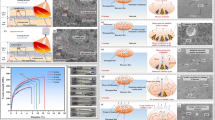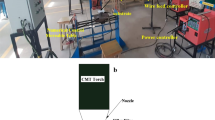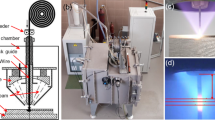Abstract
Electron beam wire-feed additive manufacturing is given less attention in research community compared with other additive manufacturing methods, despite it allows higher deposition rate and less porosity. However, both gas and shrinking porosity are still met even with this method especially if applied to light alloys. The excess heat input may be the reason for evaporation of volatile metals, and forming the gas pores especially in the top layers of the built sample where cooling rate is reduced. Therefore, exponential decay heat input was used to grow AA5356 samples. Microstructural and mechanical characterization of the samples obtained at mean low, medium, and high heat input levels was carried out. An optimal heat input gradient was determined which allowed growing a defect-free metal in the bottom part of the sample and forcing out the shrinkage cavities to the top part. Shrinkage and gas pore structure formation was analyzed as a function of the heat input gradient and along the building direction. Gas pores resulted at two higher heat input regimes as a result of evaporation of magnesium as supported by the results of EDS and XRD. Tensile test showed the ultimate strength of the defect-free part equal to that of the base AA5356.

















Similar content being viewed by others
References
Zhang J, Song B, Wei Q et al (2019) A review of selective laser melting of aluminum alloys: processing, microstructure, property and developing trends. J Mater Sci Technol 35:270–284. https://doi.org/10.1016/j.jmst.2018.09.004
Polmear IJ (1997) Wrought aluminium alloys. Mater Forum:1–26
Santos MC, Machado AR, Sales WF et al (2016) Machining of aluminum alloys: a review. Int J Adv Manuf Technol 86:3067–3080. https://doi.org/10.1007/s00170-016-8431-9
Tascioglu E, Karabulut Y, Kaynak Y (2020) Influence of heat treatment temperature on the microstructural, mechanical, and wear behavior of 316L stainless steel fabricated by laser powder bed additive manufacturing. Int J Adv Manuf Technol 107:1947–1956. https://doi.org/10.1007/s00170-020-04972-0
Fotovvati B, Asadi E (2019) Size effects on geometrical accuracy for additive manufacturing of Ti-6Al-4V ELI parts. Int J Adv Manuf Technol 104:2951–2959. https://doi.org/10.1007/s00170-019-04184-1
Kumar P, Farah J, Akram J et al (2019) Influence of laser processing parameters on porosity in Inconel 718 during additive manufacturing. Int J Adv Manuf Technol 103:1497–1507. https://doi.org/10.1007/s00170-019-03655-9
Sidambe AT (2018) Effects of build orientation on 3D-printed co-Cr-Mo: surface topography and L929 fibroblast cellular response. Int J Adv Manuf Technol 99:867–880. https://doi.org/10.1007/s00170-018-2473-0
Pasquet I, Baco-Carles V, Chamelot P et al (2020) A multimaterial based on metallic copper and spinel oxide made by powder bed laser fusion: a new nanostructured material for inert anode dedicated to aluminum electrolysis. J Mater Process Technol 278:116452. https://doi.org/10.1016/j.jmatprotec.2019.116452
Aboulkhair NT, Simonelli M, Parry L et al (2019) 3D printing of aluminium alloys: additive manufacturing of aluminium alloys using selective laser melting. Prog Mater Sci 106:100578. https://doi.org/10.1016/j.pmatsci.2019.100578
Zhuo L, Wang Z, Zhang H et al (2018) Effect of post-process heat treatment on microstructure and properties of selective laser melted AlSi10Mg alloy. Mater Lett. https://doi.org/10.1016/j.matlet.2018.09.109
Olakanmi EO, Cochrane RF, Dalgarno KW (2015) A review on selective laser sintering/melting (SLS/SLM) of aluminium alloy powders: processing, microstructure, and properties. Prog Mater Sci 74:401–477. https://doi.org/10.1016/j.pmatsci.2015.03.002
Wu B, Pan Z, Ding D et al (2018) A review of the wire arc additive manufacturing of metals : properties , defects and quality improvement. J Manuf Process 35:127–139. https://doi.org/10.1016/j.jmapro.2018.08.001
Ding D, Pan Z, Cuiuri D, Li H (2015) Wire-feed additive manufacturing of metal components: technologies, developments and future interests. Int J Adv Manuf Technol 81:465–481. https://doi.org/10.1007/s00170-015-7077-3
Taminger K, Hafley R (2003) Electron beam freeform fabrication: a rapid metal deposition process. Proceedings of the 3rd Annual Automotive Composites Conference, pp 9–10
Taminger KM, Hafley RA, Domack MS (2006) Evolution and control of 2219 aluminum microstructural features through electron beam freeform fabrication. Mater Sci Forum 519–521:1297–1304. https://doi.org/10.4028/www.scientific.net/msf.519-521.1297
Taminger KM, Domack CS, Zalameda JN et al (2016) In-process thermal imaging of the electron beam freeform fabrication process. In: Zalameda JN, Bison P (eds), p 986102
Taminger KM, Hafley RA (2004) Electron beam freeform fabrication for cost effective near-net shape manufacturing. Nato Unclassified 19
Designs S, Taminger KMB (2008) Electron beam freeform LaRC EBF 3 team. Seminar
DebRoy T, Wei HL, Zuback JS et al (2018) Additive manufacturing of metallic components – process, structure and properties. Prog Mater Sci 92:112–224. https://doi.org/10.1016/j.pmatsci.2017.10.001
Martin JH, Yahata BD, Hundley JM et al (2017) 3D printing of high-strength aluminium alloys. Nature 549:365–369. https://doi.org/10.1038/nature23894
Bose S, Ke D, Sahasrabudhe H, Bandyopadhyay A (2018) Additive manufacturing of biomaterials. Prog Mater Sci 93:45–111. https://doi.org/10.1016/j.pmatsci.2017.08.003
Hekmatjou H, Naffakh-Moosavy H (2018) Hot cracking in pulsed Nd:YAG laser welding of AA5456. Opt Laser Technol 103:22–32. https://doi.org/10.1016/j.optlastec.2018.01.020
Ojo OO, Taban E, Kaluc E (2018) Loop travel-path of fibre laser welded Alclad AA2219-O alloy. J Mater Process Technol 251:118–126. https://doi.org/10.1016/j.jmatprotec.2017.08.026
Chen Y, Lu F, Zhang K et al (2016) Investigation of dendritic growth and liquation cracking in laser melting deposited Inconel 718 at different laser input angles. Mater Des 105:133–141. https://doi.org/10.1016/j.matdes.2016.05.034
Mukherjee T, Zuback JS, Zhang W, DebRoy T (2018) Residual stresses and distortion in additively manufactured compositionally graded and dissimilar joints. Comput Mater Sci 143:325–337. https://doi.org/10.1016/j.commatsci.2017.11.026
Ding Y, Muñiz-Lerma JA, Trask M et al (2016) Microstructure and mechanical property considerations in additive manufacturing of aluminum alloys. MRS Bull 41:745–751. https://doi.org/10.1557/mrs.2016.214
Zavala-Arredondo M, Boone N, Willmott J et al (2017) Laser diode area melting for high speed additive manufacturing of metallic components. Mater Des 117:305–315. https://doi.org/10.1016/j.matdes.2016.12.095
Froend M, Riekehr S, Kashaev N et al (2018) Process development for wire-based laser metal deposition of 5087 aluminium alloy by using fibre laser. J Manuf Process 34:721–732. https://doi.org/10.1016/j.jmapro.2018.06.033
Froend M, Ventzke V, Riekehr S et al (2018) Microstructure and microhardness of wire-based laser metal deposited AA5087 using an ytterbium fibre laser. Mater Charact 143:59–67. https://doi.org/10.1016/j.matchar.2018.05.022
Jia Q, Rometsch P, Cao S et al (2019) Towards a high strength aluminium alloy development methodology for selective laser melting. Mater Des 174:107775. https://doi.org/10.1016/j.matdes.2019.107775
Croteau JR, Griffiths S, Rossell MD et al (2018) Microstructure and mechanical properties of Al-mg-Zr alloys processed by selective laser melting. Acta Mater 153:35–44. https://doi.org/10.1016/j.actamat.2018.04.053
Derekar KS (2018) A review of wire arc additive manufacturing and advances in wire arc additive manufacturing of aluminium. Mater Sci Tech (United Kingdom) 34:895–916. https://doi.org/10.1080/02670836.2018.1455012
Cunningham CR, Flynn JM, Shokrani A et al (2018) Invited review article: strategies and processes for high quality wire arc additive manufacturing. Addit Manuf 22:672–686. https://doi.org/10.1016/j.addma.2018.06.020
Thapliyal S (2019) Challenges associated with the wire arc additive manufacturing (WAAM) of aluminum alloys. Mater Res Express 6:112006. https://doi.org/10.1088/2053-1591/ab4dd4
Ryan EM, Sabin TJ, Watts JF, Whiting MJ (2018) The influence of build parameters and wire batch on porosity of wire and arc additive manufactured aluminium alloy 2319. J Mater Process Technol 262:577–584. https://doi.org/10.1016/j.jmatprotec.2018.07.030
Fixter J, Gu J, Ding J et al (2017) Preliminary investigation into the suitability of 2xxx alloys for wire-arc additive manufacturing. Mater Sci Forum 877:611–616. https://doi.org/10.4028/www.scientific.net/MSF.877.611
Gu J, Ding J, Williams SW et al (2016) The strengthening effect of inter-layer cold working and post-deposition heat treatment on the additively manufactured Al-6.3Cu alloy. Mater Sci Eng A 651:18–26. https://doi.org/10.1016/j.msea.2015.10.101
Wang H, Jiang W, Ouyang J, Kovacevic R (2004) Rapid prototyping of 4043 Al-alloy parts by VP-GTAW. J Mater Process Technol 148:93–102. https://doi.org/10.1016/j.jmatprotec.2004.01.058
Qi Z, Qi B, Cong B, Zhang R (2018) Microstructure and mechanical properties of wire + arc additively manufactured Al-mg-Si aluminum alloy. Mater Lett 233:348–350. https://doi.org/10.1016/j.matlet.2018.09.048
Zuo W, Ma L, Lu Y et al (2018) Effects of solution treatment temperatures on microstructure and mechanical properties of TIG–MIG hybrid arc additive manufactured 5356 aluminum alloy. Met Mater Int 24:1346–1358. https://doi.org/10.1007/s12540-018-0142-3
Köhler M, Fiebig S, Hensel J, Dilger K (2019) Wire and arc additive manufacturing of aluminum components. Metals 9:1–9. https://doi.org/10.3390/met9050608
Su C, Chen X, Gao C, Wang Y (2019) Effect of heat input on microstructure and mechanical properties of Al-mg alloys fabricated by WAAM. Appl Surf Sci 486:431–440. https://doi.org/10.1016/j.apsusc.2019.04.255
Oyama K, Diplas S, M’hamdi M et al (2019) Heat source management in wire-arc additive manufacturing process for Al-mg and Al-Si alloys. Addit Manuf 26:180–192. https://doi.org/10.1016/j.addma.2019.01.007
Zhang C, Li Y, Gao M, Zeng X (2018) Wire arc additive manufacturing of Al-6Mg alloy using variable polarity cold metal transfer arc as power source. Mater Sci Eng A 711:415–423. https://doi.org/10.1016/j.msea.2017.11.084
Gu J, Ding J, Williams SW et al (2016) The effect of inter-layer cold working and post-deposition heat treatment on porosity in additively manufactured aluminum alloys. J Mater Process Technol 230:26–34
Zhang C, Gao M, Zeng X (2019) Workpiece vibration augmented wire arc additive manufacturing of high strength aluminum alloy. J Mater Process Technol 271:85–92. https://doi.org/10.1016/j.jmatprotec.2019.03.028
Yuan T, Yu Z, Chen S et al (2020) Loss of elemental mg during wire + arc additive manufacturing of Al-mg alloy and its effect on mechanical properties. J Manuf Process 49:456–462. https://doi.org/10.1016/j.jmapro.2019.10.033
Ren L, Gu H, Wang W, Wang S, Li C, Wang Z et al (2019) Effect of Mg content on microstructure and properties of Al–mg alloy produced by the wire arc additive manufacturing method. Materials (Basel) 12:4160. https://doi.org/10.3390/ma12244160
Droste M, Günther J, Kotzem D et al (2018) Cyclic deformation behavior of a damage tolerant CrMnNi TRIP steel produced by electron beam melting. Int J Fatigue 114:262–271. https://doi.org/10.1016/j.ijfatigue.2018.05.031
Zhong Y, Rännar LE, Liu L et al (2017) Additive manufacturing of 316L stainless steel by electron beam melting for nuclear fusion applications. J Nucl Mater 486:234–245. https://doi.org/10.1016/j.jnucmat.2016.12.042
Tarasov SY, Filippov AV, Savchenko NL et al (2018) Effect of heat input on phase content, crystalline lattice parameter, and residual strain in wire-feed electron beam additive manufactured 304 stainless steel. Int J Adv Manuf Technol 99:2353–2363. https://doi.org/10.1007/s00170-018-2643-0
Tarasov SY, Filippov AV, Shamarin NN et al (2019) Microstructural evolution and chemical corrosion of electron beam wire-feed additively manufactured AISI 304 stainless steel. J Alloys Compd 803:364–370. https://doi.org/10.1016/j.jallcom.2019.06.246
Laptev R, Pushilina N, Kashkarov E, Syrtanov M, Stepanova E, Koptyug A, Lider A (2019) Influence of beam current on microstructure of electron beam melted Ti-6Al-4V alloy. Prog Nat Sci Mater Int 29:440–446. https://doi.org/10.1016/j.pnsc.2019.04.011
Grell WA, Solis-Ramos E, Clark E et al (2017) Effect of powder oxidation on the impact toughness of electron beam melting Ti-6Al-4V. Addit Manuf 17:123–134. https://doi.org/10.1016/j.addma.2017.08.002
Ataee A, Li Y, Fraser D et al (2018) Anisotropic Ti-6Al-4V gyroid scaffolds manufactured by electron beam melting (EBM) for bone implant applications. Mater Des 137:345–354. https://doi.org/10.1016/j.matdes.2017.10.040
Wang P, Tan X, Nai MLS et al (2016) Spatial and geometrical-based characterization of microstructure and microhardness for an electron beam melted Ti-6Al-4V component. Mater Des 95:287–295. https://doi.org/10.1016/j.matdes.2016.01.093
Wang P, Nai MLS, Lu S et al (2017) Study of direct fabrication of a Ti-6Al-4V impeller on a wrought Ti-6Al-4V plate by Electron beam melting. Jom 69:2738–2744. https://doi.org/10.1007/s11837-017-2610-5
Kalashnikov KN, Rubtsov VE, Savchenko NL et al (2019) The effect of wire feed geometry on electron beam freeform 3D printing of complex-shaped samples from Ti-6Al-4V alloy. Int J Adv Manuf Technol. https://doi.org/10.1007/s00170-019-04589-y
Sun SH, Koizumi Y, Saito T et al (2018) Electron beam additive manufacturing of Inconel 718 alloy rods: impact of build direction on microstructure and high-temperature tensile properties. Addit Manuf 23:457–470. https://doi.org/10.1016/j.addma.2018.08.017
Kontis P, Chauvet E, Peng Z et al (2019) Atomic-scale grain boundary engineering to overcome hot-cracking in additively-manufactured superalloys. Acta Mater 177:209–221. https://doi.org/10.1016/j.actamat.2019.07.041
Chauvet E, Kontis P, Jägle EA et al (2018) Hot cracking mechanism affecting a non-weldable Ni-based superalloy produced by selective electron beam melting. Acta Mater 142:82–94. https://doi.org/10.1016/j.actamat.2017.09.047
Tan Y, You X, You Q et al (2016) Microstructure and deformation behavior of nickel based superalloy Inconel 740 prepared by electron beam smelting. Mater Charact 114:267–276. https://doi.org/10.1016/j.matchar.2016.03.009
Kotzem D, Arold T, Niendorf T (2020) Damage tolerance evaluation of E-PBF-manufactured Inconel 718 strut geometries by Advanced Characterization Techniques Materials 13:247. https://doi.org/10.3390/ma13010247
Kotzem D, Arold T, Niendorf T, Walther F (2020) Influence of specimen position on the build platform on the mechanical properties of as-built direct aged electron beam melted Inconel 718 alloy. Mater Sci Eng A 772:138785. https://doi.org/10.1016/j.msea.2019.138785
Mahale T, Cormier D, Harrysson O, Ervin K (2007) Advances in electron beam melting of aluminum alloys. 18th solid freeform fabrication symposium. SFF 2007:312–323
Frigola P, Harrysson O, Horn T et al (2014) Fabricating copper components. Adv Mater Process 172:20–24
Lodes MA, Guschlbauer R, Körner C (2015) Process development for the manufacturing of 99.94% pure copper via selective electron beam melting. Mater Lett 143:298–301. https://doi.org/10.1016/j.matlet.2014.12.105
Raab SJ, Guschlbauer R, Lodes MA, Körner C (2016) Thermal and electrical conductivity of 99.9% pure copper processed via selective Electron beam melting. Adv Eng Mater 18:1661–1666. https://doi.org/10.1002/adem.201600078
Guschlbauer R, Momeni S, Osmanlic F, Körner C (2018) Process development of 99.95% pure copper processed via selective electron beam melting and its mechanical and physical properties. Mater Charact 143:163–170. https://doi.org/10.1016/j.matchar.2018.04.009
Pobel CR, Lodes MA, Körner C (2018) Selective Electron beam melting of oxide dispersion strengthened copper. Adv Eng Mater 20:1–7. https://doi.org/10.1002/adem.201800068
Wolf T, Fu Z, Körner C (2019) Selective electron beam melting of an aluminum bronze: microstructure and mechanical properties. Mater Lett 238:241–244. https://doi.org/10.1016/j.matlet.2018.12.015
Domack MS, Taminger KM, Begley M (2009) Metallurgical mechanisms controlling mechanical properties of aluminium alloy 2219 produced by Electron beam freeform fabrication. Mater Sci Forum 519–521:1291–1296. https://doi.org/10.4028/www.scientific.net/msf.519-521.1291
Yu P, Yan M, Tomus D et al (2018) Microstructural development of electron beam processed Al-3Ti-1Sc alloy under different electron beam scanning speeds. Mater Charact 143:43–49. https://doi.org/10.1016/j.matchar.2017.09.005
Sun S, Zheng L, Peng H, Zhang H (2016) Microstructure and mechanical properties of Al-Fe-V-Si aluminum alloy produced by electron beam melting. Mater Sci Eng A 659:207–214. https://doi.org/10.1016/j.msea.2016.02.053
Behzad F, Alireza Etesami S, Asadi E (2019) Process-property-geometry correlations for additively-manufactured Ti-6Al-4V sheets. Mater Sci Eng A 760:431–447. https://doi.org/10.1016/j.msea.2019.06.020
Acknowledgments
The work was performed according to the Government research assignment for ISPMS SB RAS, project №III.23.2.
Funding
X-Ray micro-diffraction analysis of worn surfaces was funded by RFBR according to the research Project no. 19-38-90072.
Author information
Authors and Affiliations
Corresponding author
Additional information
Publisher’s note
Springer Nature remains neutral with regard to jurisdictional claims in published maps and institutional affiliations.
Rights and permissions
About this article
Cite this article
Utyaganova, V.R., Filippov, A.V., Shamarin, N.N. et al. Controlling the porosity using exponential decay heat input regimes during electron beam wire-feed additive manufacturing of Al-Mg alloy. Int J Adv Manuf Technol 108, 2823–2838 (2020). https://doi.org/10.1007/s00170-020-05539-9
Received:
Accepted:
Published:
Issue Date:
DOI: https://doi.org/10.1007/s00170-020-05539-9




